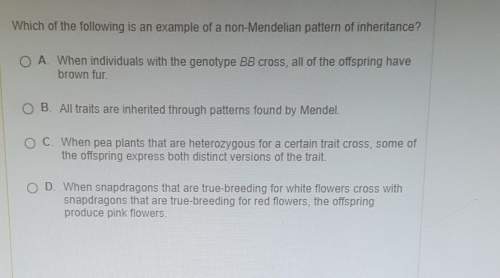2. each of us has sets of traits that make us unique.
3. traits are passed from generation to...

Biology, 06.11.2019 04:31, starbae1084
2. each of us has sets of traits that make us unique.
3. traits are passed from generation to
4. we inherit our traits from our parents and them eventually to our children.
5. traits make up one’s physical makeup.
6. physical traits include and
7. traits are characteristics on how one acts or behaves.
8. a sheepdog’s instinct is a good example of a behavioral trait.
9. to a medical condition is another inheritable trait. examples include sickle cell anemia, cystic fibrosis, and certain mental illnesses.
10. the instructions encoded on our play a role in defining traits.
11. however, the “” influences in our lives are just as important in shaping our traits.
12. our genes determine our natural hair color; however, to the sun and hair dyes can easily change that color.
13. traits can be influenced by trainers, like training dogs to chase things and bring them back.
14. a person may be born with a predisposition to heart disease; however a healthy diet and exercise can greatly this risk.
15. how are traits determined? try to bend your thumbs back at a 45 degree angle, if you can, you have the “” thumb gene.
16. other people have straight thumbs which bend.
17. scientist describe a set of genetic information for each form as an
18. we can describe the straight thumb allele with a and the hitchhiker’s thumb allele with an
19. each of us has alleles that determine the thumb extension trait.
20. what two genotypes would code for straight fingers?
21. what genotype would code for hitchhiker’s thumb?
22. having two of the same alleles for a trait are called
23. having two different alleles for a trait are called
24. a person with a hh genotype would have the finger phenotype.
25. the dominant allele (h) will mask or hide the recessive (h). this is known as the law of
26. what are the chances of having a child with hitchhiker’s thumb if both parents are hybrids? show work

Answers: 1
Other questions on the subject: Biology

Biology, 21.06.2019 21:20, cxndii13
Indicate whether the following statements about the biases in the fossil record are true or false. a) inland species are more likely to be preserved than marine species b) organisms with hard body parts are more likely to be preserved than are those composed soft tissues. c) species that existed over a larger area are more likely to be preserved than species existing over a smaller area. d) organisms that lived very long ago are more likely to be found as fossils than organisms that lived relatively recently e) the fossils of larger organisms are more likely to be found than the fossils of smaller organisms
Answers: 2

Biology, 21.06.2019 22:30, brandyleemom3
How can you approximate the number of calories required to keep you in energy balance?
Answers: 2

Biology, 22.06.2019 13:10, cruzsuarezjanca
The importance of the mind as a part of the body is an example of:
Answers: 1

Biology, 22.06.2019 14:50, allisonlillian
Which of the following is not a type of epithelial cell
Answers: 1
Do you know the correct answer?
Questions in other subjects:



English, 03.12.2021 23:40


Mathematics, 03.12.2021 23:40

Mathematics, 03.12.2021 23:40


Mathematics, 03.12.2021 23:40









